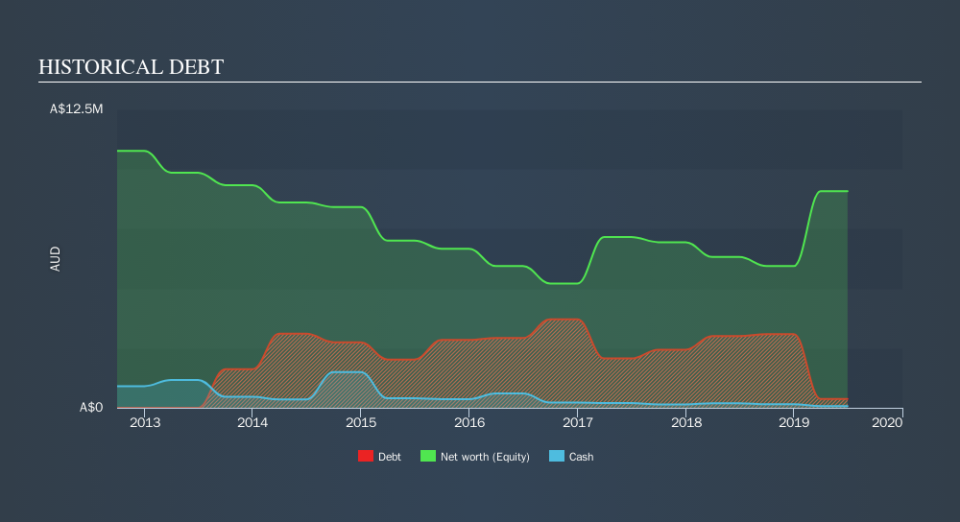AstiVita (ASX:AIR) Is Making Moderate Use Of Debt

The external fund manager backed by Berkshire Hathaway's Charlie Munger, Li Lu, makes no bones about it when he says 'The biggest investment risk is not the volatility of prices, but whether you will suffer a permanent loss of capital.' It's only natural to consider a company's balance sheet when you examine how risky it is, since debt is often involved when a business collapses. As with many other companies AstiVita Limited (ASX:AIR) makes use of debt. But the more important question is: how much risk is that debt creating?
When Is Debt Dangerous?
Generally speaking, debt only becomes a real problem when a company can't easily pay it off, either by raising capital or with its own cash flow. Part and parcel of capitalism is the process of 'creative destruction' where failed businesses are mercilessly liquidated by their bankers. While that is not too common, we often do see indebted companies permanently diluting shareholders because lenders force them to raise capital at a distressed price. Of course, the upside of debt is that it often represents cheap capital, especially when it replaces dilution in a company with the ability to reinvest at high rates of return. When we think about a company's use of debt, we first look at cash and debt together.
See our latest analysis for AstiVita
What Is AstiVita's Debt?
The image below, which you can click on for greater detail, shows that AstiVita had debt of AU$369.0k at the end of June 2019, a reduction from AU$3.01m over a year. However, because it has a cash reserve of AU$73.0k, its net debt is less, at about AU$296.0k.
How Strong Is AstiVita's Balance Sheet?
According to the last reported balance sheet, AstiVita had liabilities of AU$513.0k due within 12 months, and liabilities of AU$510.0k due beyond 12 months. Offsetting these obligations, it had cash of AU$73.0k as well as receivables valued at AU$1.08m due within 12 months. So it actually has AU$127.0k more liquid assets than total liabilities.
This state of affairs indicates that AstiVita's balance sheet looks quite solid, as its total liabilities are just about equal to its liquid assets. So it's very unlikely that the AU$12.9m company is short on cash, but still worth keeping an eye on the balance sheet. There's no doubt that we learn most about debt from the balance sheet. But it is AstiVita's earnings that will influence how the balance sheet holds up in the future. So when considering debt, it's definitely worth looking at the earnings trend. Click here for an interactive snapshot.
In the last year AstiVita actually shrunk its revenue by 16%, to AU$4.9m. That's not what we would hope to see.
Caveat Emptor
Not only did AstiVita's revenue slip over the last twelve months, but it also produced negative earnings before interest and tax (EBIT). To be specific the EBIT loss came in at AU$683k. But that EBIT loss wasn't as bad as the year before. On a more positive note, the company does have liquid assets, so it has a bit of time to improve its operations before the debt becomes an acute problem. But we'd want to see some positive free cashflow before spending much time on trying to understand the stock. So it seems too risky for our taste. When I consider a company to be a bit risky, I think it is responsible to check out whether insiders have been reporting any share sales. Luckily, you can click here ito see our graphic depicting AstiVita insider transactions.
At the end of the day, it's often better to focus on companies that are free from net debt. You can access our special list of such companies (all with a track record of profit growth). It's free.
We aim to bring you long-term focused research analysis driven by fundamental data. Note that our analysis may not factor in the latest price-sensitive company announcements or qualitative material.
If you spot an error that warrants correction, please contact the editor at editorial-team@simplywallst.com. This article by Simply Wall St is general in nature. It does not constitute a recommendation to buy or sell any stock, and does not take account of your objectives, or your financial situation. Simply Wall St has no position in the stocks mentioned. Thank you for reading.

